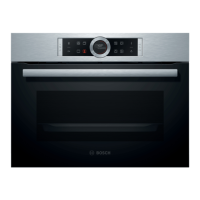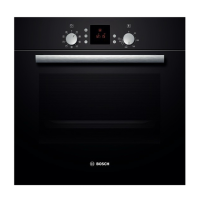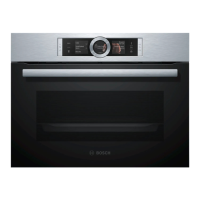NL Tested for you in our cooking studio.
Dish Accessories/shapes slide-in
height
confuse
ming culture in °C
method
Tempera- grill-
position
Duration in
min.
Chicken sticks, nuggets, frozen
Poularde, 1.5 kg
universal pan
Schedule
2
1
$
7
200-220
200-220
- 10-20
70-90-
Duck & Goose
Duck, 2 kg
Duck breast, 300 g each
Goose, 3 kg
Goose legs, 350 g . each
Schedule
Schedule
Schedule
Schedule
1
2
1
2
7
7
7
7
180-200
230-250
160-180
210-230
- 90-110
25-30
120-150
40-50
-
-
-
Turkey
Turkey, 2.5 kg
Turkey breast, boned, 1 kg
Turkey thigh, boned, 1 kg
* 5 min preheating
Schedule
Closed shape
Schedule
1
1
1
7
%
7
180-190
240-260
180-200
- 70-90
80-100
80-100
-
-
Meat
Add a little liquid to lean meat. In glass molds, the
bottom of the mold should be covered approx. ^ cm
high.
Your appliance offers numerous heating methods for
cooking meat. In the setting tables you will find
optimal settings for many dishes.
The amount of liquid depends on the type of meat and
the material of the molds and whether you use a lid.
When cooking meat in enamelled or dark roasting
pans, a little more liquid is needed than in glass pans.
Roast and stew
Brush lean meats with fat as desired or top with
strips of bacon.
During roasting, the liquid in the mold evaporates. If
necessary, carefully add some liquid.
Cut a rind crosswise. When turning the roast, make
sure that the rind is covered first.
Shiny roasting pans made of stainless steel or
aluminum reflect the heat like a mirror and are
therefore not very suitable. The meat cooks more
slowly and browns less. Use a higher temperature and/
or longer cooking time.
When the roast is ready, it must remain in the switched-off,
closed cooking compartment for another 10 minutes. This
allows the meat juice to distribute itself better. Wrap the
roast meat. in aluminum foil. The indicated cooking time
does not include the recommended rest time.
Follow the roasting pan manufacturer's directions.
Roast on the grid
Meat becomes particularly crispy from all sides on
the grill.
open shape
It is best to use a high pan for roasting meat. Place the
mold on the grid. If you do not have a suitable shape,
use the roasting tray.
Depending on the size and type of meat, pour up to liter of
water into the roasting pan. Dripping fat and meat juices
are collected. You can prepare a sauce from this cooking
liquid. In addition, less smoke is created and the interior
space remains cleaner.
Closed shape
The interior remains much cleaner when prepared in a
closed form. Make sure that the lid fits in front of the pan
and closes properly. Place the mold on the grid.
Slide the roasting tray with the rack into the indicated shelf
position. Make sure that the grid is positioned correctly on
the roasting tray. ~"
Accessories" on page 12
The distance between the meat and the lid must be
at least 3 cm. The meat may expand during cooking.
Roast and stew in a mould
When opening the lid after cooking, very hot steam
can escape. Lift the lid from behind so that the hot
steam escapes from the body.
Roasting and stewing in a mold is more comfortable. It is
easier to remove the roast from the cooking
compartment with the tin and prepare the sauce directly
in the tin.
Before stewing, brown the meat as desired. For the
cooking juice, add water, wine, vinegar or the like. The
bottom of the mold should be covered about 1-2 cm.
Only use molds that are suitable for oven operation.
Check whether the mold fits into the interior space.
Glass shapes are the most suitable. Place hot glass
molds on a dry coaster. If the surface is wet or cold,
the glass can crack.
During roasting, the liquid in the mold evaporates. If
necessary, carefully add some liquid.
38

